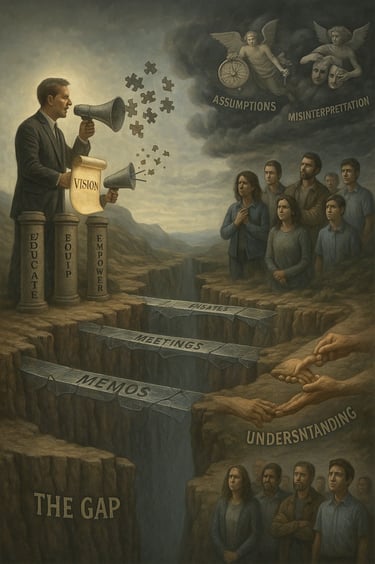The Myth of Communication: Why Clarity Is Not Always Connection
Clear communication doesn’t always lead to true understanding. In this post, Dr. Marion Mouton explores the gap between what’s said and what’s actually heard unpacking why clarity isn’t enough in leadership. Discover how psychological safety, cognitive load, and authentic connection shape whether your message lands or gets lost in translation.
LEADERSHIPCOMMUNICATION
7/31/20252 min read


I once walked out of a leadership meeting feeling confident that I had communicated the vision with clarity and purpose. But days later, I overheard a hallway conversation that revealed a startling truth what I thought was crystal clear had been filtered, misinterpreted, and reduced to a checklist. That moment challenged my belief that clarity was enough. I learned that communication isn’t just about what is said, but what is understood, felt, and internalized.
Quick Fact
According to a 2023 McKinsey report, 61 percent of employees say they often feel confused after meetings, even when the message was “clear.”
Leaders often assume that clarity equals communication. That if the message is structured, repeated, and posted it has been received. But the truth is, clarity without connection is just noise. The myth lies in thinking that well-delivered communication ensures shared understanding.
The real issue is the gap between what was said and what was heard. This gap widens in environments lacking psychological safety, where team members are hesitant to ask for clarification or challenge assumptions. It deepens under cognitive load when overwhelmed staff nod along but mentally check out. And it becomes dangerous when communication focuses on compliance over commitment.
When people hear directives but don’t feel empowered to ask “why” or “how,” we get short-term obedience instead of long-term transformation. That’s the difference between surface-level clarity and true connection.
Being an effective school leader requires more than clear communication it demands communication with empathy, feedback loops, and trust. We aim to educate minds, empower hearts, and equip hands, but we must also ensure that our messages resonate, not just land.
That means we must slow down, check for understanding, ask better questions, and actively listen. It means building systems that support clarity and connection not just pushing out information, but pulling people into the process.
In a high-stakes environment like ours, the cost of misunderstanding is too great. We can no longer confuse clarity with consensus or assume that a nod means alignment. Leadership is about closing the communication gap, not just widening the megaphone.
Final Thought
To truly lead, we must communicate beyond logistics and lean into meaning. Clarity is the starting point. Connection is the finish line.
“Communication works for those who work at it.” — John Powell
Call to Action
This week, pause after delivering your next message. Ask three different people to explain what they heard, how it made them feel, and what they plan to do next. Use that feedback to refine your leadership communication not just for clarity, but for connection.
Three Reflective Leadership Questions
1. What systems do I have in place to check for understanding beyond surface-level responses?
2. How am I creating psychological safety in my team to encourage honest feedback about my communication?
3. Am I prioritizing compliance or cultivating true commitment through my message delivery?
Let’s continue to educate minds, empower hearts, and equip hands with communication rooted in clarity and consistency, but elevated by authentic connection.
